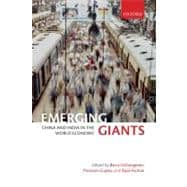
Note: Supplemental materials are not guaranteed with Rental or Used book purchases.
Purchase Benefits
What is included with this book?
| List of Tables | p. xi |
| List of Figures | p. xv |
| List of Contributors | p. xix |
| Abbreviations | p. xxi |
| Introduction | p. xxv |
| China and India in the global economy | p. xxvi |
| Comparisons and contrasts | p. xxviii |
| Challenges for sustaining growth | p. xxix |
| China and India in the Global Economy | |
| What Can Be Learned about the Economies of China and India from Purchasing Power Comparisons? | p. 3 |
| Introduction | p. 3 |
| The growth record in a comparative framework | p. 4 |
| Levels of GDP in China and India | p. 8 |
| PPPs and sources of past and future growth | p. 22 |
| PPPs and exchange rates | p. 28 |
| Conclusions | p. 30 |
| Trading with Asia's Giants | |
| Introduction | p. 32 |
| Context | p. 34 |
| Services trade | p. 39 |
| Composition of goods exports | p. 42 |
| The role of multinational corporations | p. 44 |
| The role of distance | p. 47 |
| Effects of the US trade deficit | p. 55 |
| Conclusion | p. 59 |
| The Chinese Export Bundles: Patterns, Puzzles, and Possible Explanations | p. 62 |
| Introduction | p. 62 |
| Evolving sophistication in export structures: China vs. India | p. 63 |
| What might explain China's precocious export sophistication? | p. 69 |
| Conclusion | p. 79 |
| Data | p. 81 |
| Contrasts in Development Experience | |
| The Cost Competitiveness of Manufacturing in China and India: An Industry and Regional Perspective | p. 87 |
| Introduction | p. 87 |
| Unit labor cost as competitiveness measure | p. 89 |
| International comparisons of productivity and unit labor costs | p. 92 |
| Regional comparison of productivity and unit labor cost | p. 96 |
| Convergence trends in compensation, productivity, and unit labor cost | p. 107 |
| Conclusion | p. 116 |
| Basic data for China and India regional comparisons | p. 118 |
| Law, Institutions, and Finance in China and India | p. 125 |
| Introduction | p. 125 |
| Evidence on China's legal and financial systems and growth in the three sectors | p. 129 |
| Law, finance, and growth in India: Aggregate evidence | p. 144 |
| Firms' financing sources in China: Aggregate evidence and cross-country comparisons | p. 151 |
| Law, finance, and growth in the Indian corporate sectors: Firm level evidence | p. 161 |
| Survey evidence on the Chinese Private sector | p. 167 |
| Conclusions | p. 181 |
| China and India: A Tale of Two Trade Integration Approachers | p. 184 |
| Introduction | p. 184 |
| Main trade developments | p. 189 |
| Trade policy developments | p. 206 |
| Conclusion | p. 223 |
| Challenges to Sustaining Growth | |
| China's Growth Model: Choices and Consequences | p. 227 |
| Introduction | p. 227 |
| The composition of growth in China and India | p. 229 |
| Policy choices | p. 232 |
| The reform agenda | p. 237 |
| Monetary policy | p. 239 |
| Concluding remarks | p. 241 |
| Deconstructing China's and India's Growth: The Role of Financial Policies | p. 243 |
| Introduction | p. 243 |
| China and India's recent growth experience | p. 248 |
| China and India's economy as a neoclassical growth model | p. 249 |
| Calibrating the growth Model | p. 252 |
| Simulating the Solow growth model | p. 255 |
| Investment wedge | p. 257 |
| Interpreting investment wedges as financial frictions | p. 260 |
| Financial sector reforms in India | p. 272 |
| Conclusion | p. 276 |
| Pollution across Chinese Provinces | p. 281 |
| Introduction | p. 281 |
| Pollution and environmental policy in China | p. 284 |
| Data and empirical methodology | p. 286 |
| Analysis of results | p. 291 |
| Conclusion | p. 304 |
| p. 306 | |
| What constrains Indian Manufacturing? | p. 307 |
| Introduction | p. 307 |
| Stylized facts and preliminary evidence | p. 312 |
| Evidence from enterprise surveys | p. 319 |
| Econometric analysis | p. 323 |
| Conclusion | p. 337 |
| Data sources and construction of variables | p. 339 |
| References | p. 343 |
| Index | p. 363 |
| Table of Contents provided by Ingram. All Rights Reserved. |
The New copy of this book will include any supplemental materials advertised. Please check the title of the book to determine if it should include any access cards, study guides, lab manuals, CDs, etc.
The Used, Rental and eBook copies of this book are not guaranteed to include any supplemental materials. Typically, only the book itself is included. This is true even if the title states it includes any access cards, study guides, lab manuals, CDs, etc.